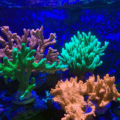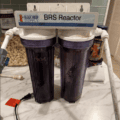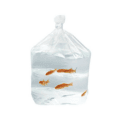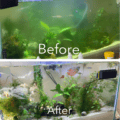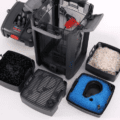Live plants can add color to your aquarium, and also excel at purifying and oxygenating water to help improve the health of your system.
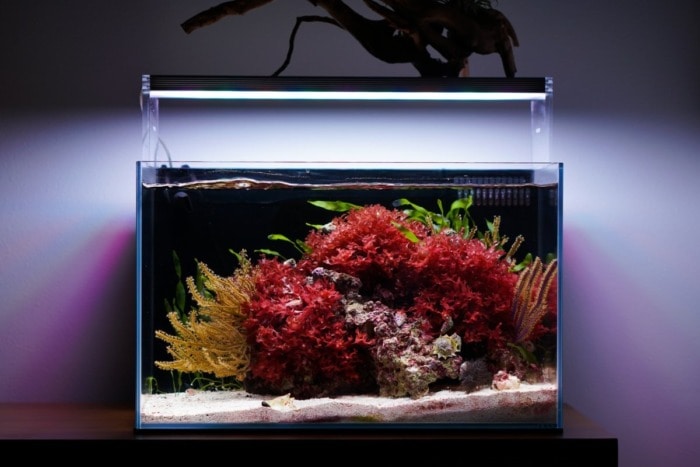
I’ve done some research and sifted out the best ideas for saltwater aquarium plants to help those who are new to this kind of setup.
Most of the species I’m about to list are actually macroalgae and would typically be put in a dedicated display tank.
Each live marine plant has its unique texture and characteristics but I managed to cherry-pick the pretty varieties.
That being said, let me show you the saltwater plants that can make up a fantastic planted tank, as well as their unique care requirements and what makes them special.
The 21 Best Live Saltwater Aquarium Plants for a Spectacular Aquascape
Unlike the abundancy of plants that grow in freshwater, there are not many aquatic plant species that can survive in saltwater. Seagrass is one of the few that can but is difficult to hunt down and source.
Macroalgae species, however, are a very popular plant choice in the saltwater aquarium hobby.
That’s because they look good in a marine fish tank, and provide the system with a decent nutrient export since most of them grow really fast.
Macroalgae are basically seaweeds composed of multicellular algae that form a plant-like structure.
Below are some of my favorite species, as well as a bit of information about why I like them so much.
To create a striking aquascape you can try these saltwater aquarium plants:
1. Rose Petal Macroalgae

by barscaz
The Rose Petal macroalgae look like a beautifully wrinkled rose sheet that stays in a bushy shape.
Its unusual looks make for a good diversification on your saltwater planted tank’s aquascape.
This type of macroalgae grows relatively slowly and does not take over a tank quickly.
I’d say the Rose Petal is a must-have saltwater plant in any ambitious display aquarium.
2. Blue Hypnea

by HuskerBioProf
The Blue Hypnea is a saltwater species of plant-like macroalgae that I would describe as resembling a frozen, leafless crown of a tree.
It has a unique neon-blue color, which adds a striking touch to a tank and contributes to a colorful view.
The blue Hypnea grows in bushy clusters and is not as invasive as other saltwater plants can be.
My experience has been that, with its slow growth rate this aquarium plant remains easy to manage.
Anyway, the Blue Hypnea prefers tropical aquarium temperatures and does best under strong lighting. LED lights designed for planted tanks provide a good spectrum for healthy Blue Hypnea growth.
3. Tufted Joint Algae – Cymopolia barbata

by _divad
Resembling a small tree, the unusual growth habit of the Tufted Joint algae makes it a “must-have” addition to your saltwater aquarium.
Coming in a vivid, bright green color, tufted joint algae boasts a tree-like, segmented trunk.
The trunk itself terminates in fuzzy, leaf-like protuberances at the top.
While this plant can be attached to different surfaces, it often looks best when secured to a section of live rock.
Great for setups with angelfish and tangs, any clippings you take from this plant can be fed to herbivorous fish and algae eaters as a snack.
4. Grape Caulerpa

by Sdiesel77
Grape Caulerpa, also known as Caulerpa racemosa, is fast-growing macroalgae that are somewhat invasive.
I would not recommend introducing this plant to a reef aquarium because it could take over and spoil the coral aquascape.
However, a dedicated display tank with saltwater plants can be the perfect setup for Grape Caulerpa.
This plant has a distinctive grape-like texture which plays well in a saltwater tank with pointy, bushy plants.
Author’s note: Carbon filtering should be running along with this plant because of the slight possibility of it releasing some toxins in the water. Nothing to worry about, since there are many aquarists who’ve managed to keep it alongside other plants and fish.
5. Dragon’s Tongue algae – Halymenia dilatata

by smsreef
Notable for its distinct fronds and deep red color, the Dragon’s Tongue is a great choice for a saltwater planted tank.
It’s a plant that can add contrast to an otherwise green aquarium landscape.
Resembling a small shrub or tree, this pretty and fast-growing macroalgae is sure to please.
Just be advised that it can be quite appealing to some herbivorous fish who may try to eat it.
Anyway, you can glue the Dragon’s Tongue plant to rock.
If you decide to do so, use some sorf ot aquarium-safe super glue. The criteria for a super glue to be safe for aquarium use are:
- It has Cyanoacrylate as its main ingredient;
- Lacks additives;
- Doesn’t contain mold inhibitors.
Dragon’s Tongue is not to be mistaken with Dragon’s Breath. Both plants look somewhat similar to the untrained eye but have slightly different textures.
6. Blue Scroll
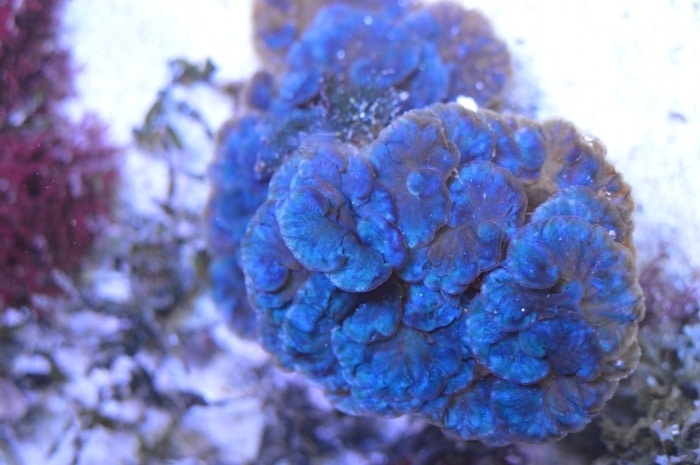
by acbaldwin
The Blue Scroll macroalgae look like a mushroom you’d find growing on an old trunk in the forest.
However, imagine that this mushroom has multiple shades of fluorescent blue.
That’s Blue Scroll algae for you.
Keeping this plant in your marine aquarium requires a little more on the nutrient side.
Running a tank with upward of 20 ppm of Nitrate is recommended and intense lighting helps.
7. Turtle Grass Shoots – Thalassia testudinum

by Brandon McHenry
A native of the Gulf Coast of Florida, turtle grass is a beautiful plant that looks particularly pretty when moving back and forth with the currents in your tank.
It requires lots of light and a moderate water flow.
For this reason, some consider it somewhat difficult to create the correct conditions to keep this plant happy.
However, if you can, it is well worth the effort.
Lending a natural look to your setup, turtle grass looks very appealing when planted in groups on a sand substrate.
8. Neomeris annulata

by bluenassarius
The Neomeris is a marine plant with unique worm-like shoots that are bright green in color.
I decided to include it in this list because it’s another macroalgae with a fun texture.
It’s best to include it in your display planted tank if need something green that grows slowly.
Neomeris does have the potential to become invasive but its slow growth rate makes it easier to maintain.
It’s also calcified which means that not many fish will have a taste for it.
To contain the spread of Neomeris even better you should keep the aquarium’s Calcium levels low.
See how floating plants can enhance your aquarium’s ecosystem in this detailed guide.
9. Nemastoma spp.
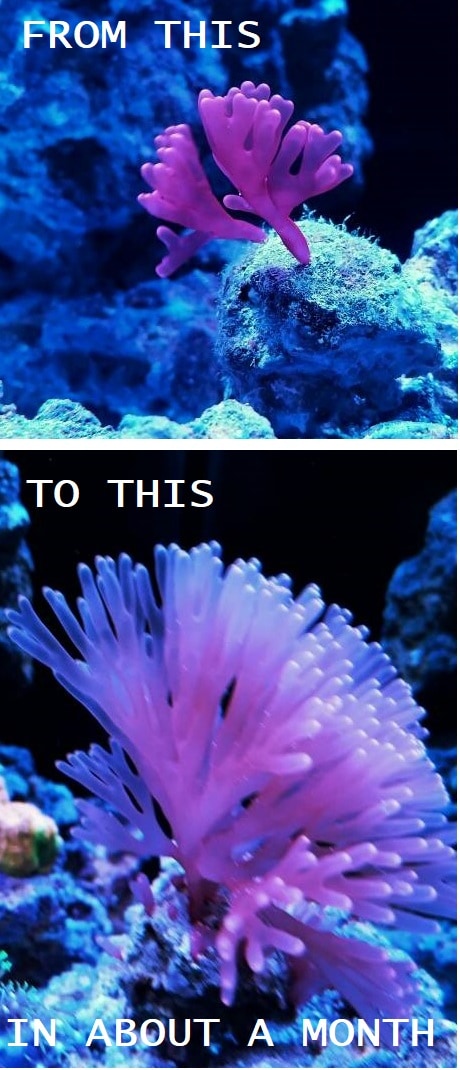
by GOSKN5
The Nemastoma macroalgae is a pretty diverse genus of red and even pink saltwater algae plants.
You could see a lot of slightly different variations called Nemastoma if you go ahead and look up the thing.
However, every single one of them will be a fast grower that does not spread too wildly in a display tank.
This saltwater plant looks so good that some reef keepers decide to keep it, even if it has sprouted uninvited in their aquariums at first.
10. Mermaid’s Fan – Halimeda udotea

by TurbulentWiggles
An unusual plant that grows a single, bright green, fan-shaped leaf, Mermaid’s Fan does best when provided with a little additional light.
Sensitive to high Nitrate and Phosphate levels, if you plan on keeping Mermaid’s Fan, be prepared to monitor your water frequently.
This is done to ensure all compound levels are in a suitable range for this sensitive plant.
Containing large amounts of calcium in its leaves, Mermaid’s Fan is undesirable to most fish.
This, in itself, is a selling point in my book, if I’m looking for a plant my fish won’t be tempted to snack.
11. Halymenia maculata

by sixty_reefer
To me, all plants from the Halymena genus look like someone froze a flame in motion.
I chose Halymena maculata for this list because of its striking tendency to display bicolor tissue.
Having such coloration is not something you see too often when it comes to saltwater aquarium plants.
Anyway, this macroalgae thrives under full to blue-ish spectrum lights and grows rather slow.
Halymenia maculata can be an ideal centerpiece plant for an aquascape that’s mainly composed of green and blue plants.
Thinking about painting aquarium decorations? Find out how in this informative aquarium-safe paint article.
12. Red Mangrove Propagule – Rhizophora mangle

by pgravis
An easy-to-grow plant, mangroves can adapt to many different substrates.
Additionally, mangroves add height to your setup.
That’s because the leaves of the mangrove plant need to be above the waterline of your aquarium.
Ideal for adding to systems with sand or live rock substrates, mangroves look particularly alluring when planted together in groups.
Planted like this can give them the appearance of tiny bamboo forests inside your saltwater aquarium.
13. Pink lace macroalgae
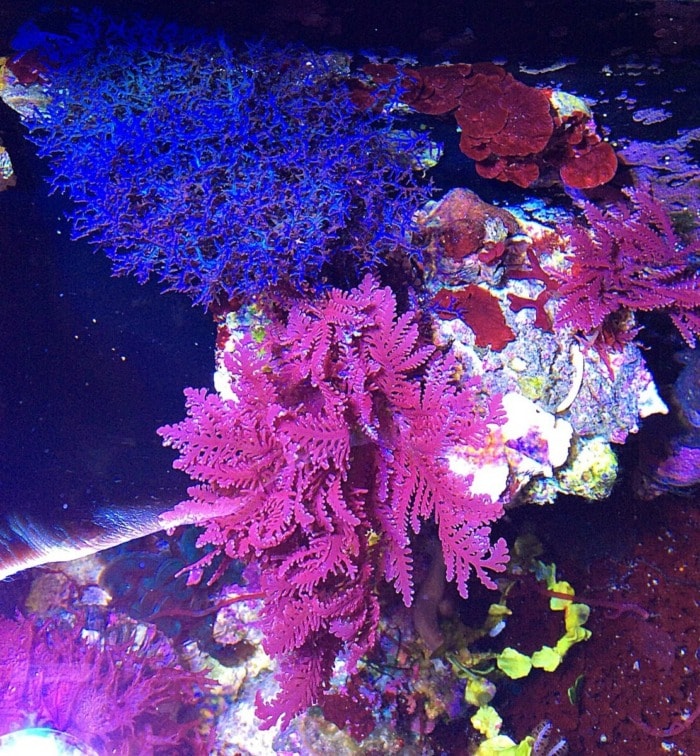
by Macrochick
Pretty in pink, the pink lace macroalgae is a must-have for your saltwater aquarium, especially if you intend to keep common or dwarf seahorses.
While Pink Lace is notable for its deep, rich color, it offers an interesting texture to your aquarium’s aquascape.
Also, it is an ideal feeding station for resident seahorses who will attach to its limbs while browsing for food.
14. Spaghetti Algae – Chaetomorpha linum
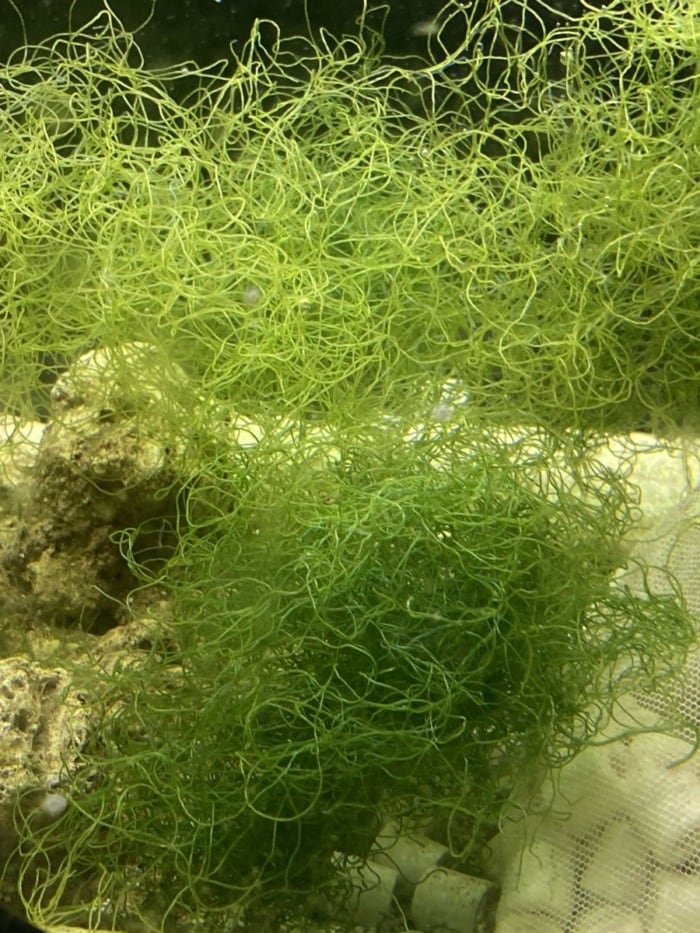
by JumpingFlea
The dense, clustered growth habit of spaghetti algae makes it an excellent refuge for marine nano fish who are looking for a place to hide.
Ideal for oxygenating water and absorbing Nitrates, this hardworking little plant is also great for balancing the pH of the water.
Moreover, Spaghetti Algae is one of the best plants to choose from if you need help regulating the ammonia cycle in your tank.
In my experience, this Chaeto species greatly benefits from LED lighting designed to grow Chaetomorpha macroalgae in refugiums.
Anyway, Aquarists use this plant differently in their setups, with some opting to attach it to rocks, while others preferring to float it freely in the water.
Undesirable to most fish, the Spaghetti Algae is a good choice if you want a plant that aquatic pets won’t munch on.
15. Pinecone algae – Rhipocephalus phoenix

Naturally found in the tropical waters of the West Atlantic, this calcareous alga grows in short, 6″ clusters that are said to resemble pinecones.
Appropriate for either reef or fish tanks, pinecone algae uses the rhizoids of its root-like bulbs to secure itself to reef flats or sandy seagrass beds.
Preferring bright light and gentle currents, this plant grows best when calcium and alkalinity levels are slightly higher than normal.
While undesirable to most fish, sea urchins have been known to snack on this cheery plant from time to time.
16. Sea Lettuce – Ulva lactuca

by Abhishek
A classic saltwater aquarium plant, it’s no wonder why the Sea Lettuce plant is so popular with marine tank keepers.
While it may not visually be a showstopper, this little powerhouse of a plant grows incredibly fast.
Its fast growth rate is one of the reasons why the Sea lettuce is stellar at moderating Nitrates, Phosphates, and other impurities in your tank.
Consequently, having this plant in your saltwater aquarium helps to ensure your fish stay healthy.
Preferring bright light and a strong water current, clippings of Sea Lettuce can be fed to herbivorous fish as part of their balanced diet.
17. Scinaia macroalgae – Scinaia complanata

by Macrochick
A slightly more difficult macroalgae to keep, the Scinaia plant can be easily harmed by mishandling and requires stable water parameters to thrive.
With a stunning red to pink hue, this saltwater macroalgae does best in a setup with moderate light and water flow.
These conditions will cause the Scinaia plant to grow at a consistent if moderate, rate.
With an interesting growth pattern formed by clumps of small leaf-like structures that widen towards the top of the plant, Scinaia grows approximately 5″ high by 4 to 5″ wide.
When attached to rocks or other objects, this macroalgae will grow quite happily.
However, be advised that herbivorous fish and crustaceans may take a nibble from time to time.
If your plant looks like it needs a pick-me-up, try dosing it with some iodine.
18. Halimeda species
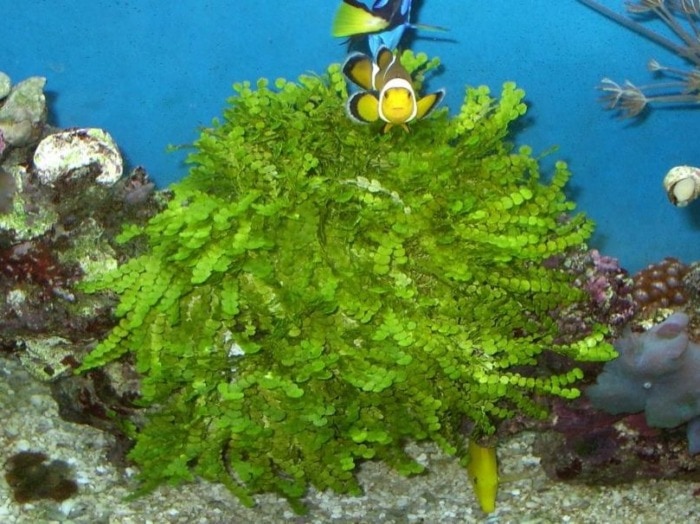
by navila06
Another unique plant with an unusual growth habit, Halimeda grows in segments.
Even more interesting, however, is that on a cellular level, each large Halimeda cell contains multiple nuclei.
Well-suited for attaching to a reef bottom or a section of live rock, this adaptable plant is known for being able to absorb excess calcium in your tank.
In fact, the ability of this plant to thrive in your system can indicate that your aquarium has adequate calcium levels to support coral growth.
19. Red Dictyota – Dictyota species
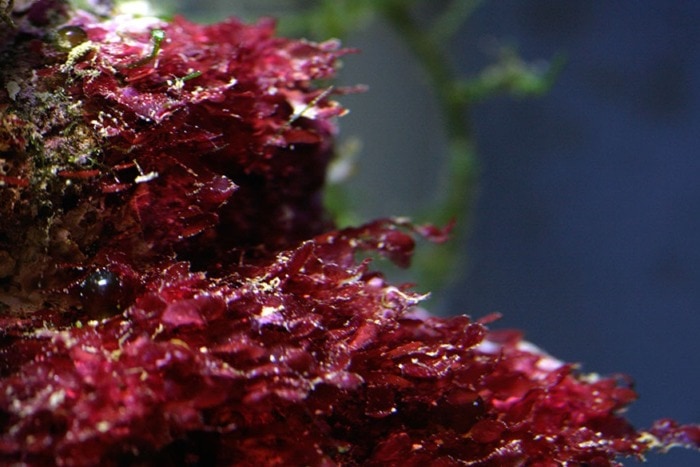
by Shulz
Requiring moderate care, bright light, and a low flow rate, the Red Dictyota attaches to the substrate using vigorous rhizoids.
These rhizoids help anchor its leafy, reddish-brown flattened fronds to sandy or rocky landscapes.
Naturally found in the European Atlantic and the Mediterranean Sea, Red Dictyota is excellent at nutrient control and is generally reef safe.
However, it has a tendency to spread quickly, so growth should be monitored accordingly.
20. Green Bush macroalgae – Cladophora prolifera
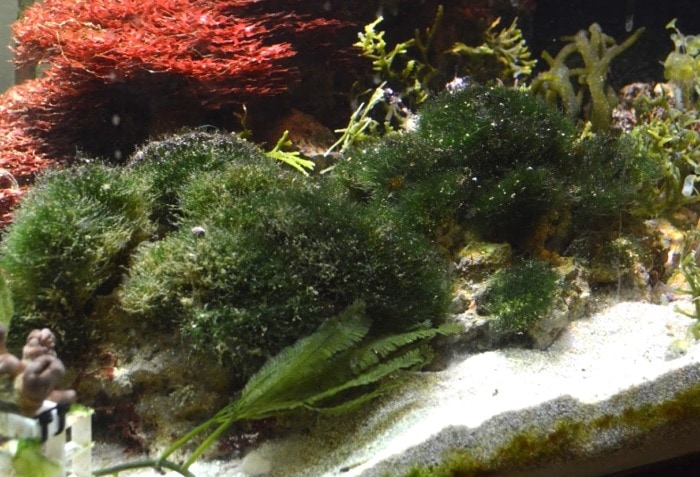
by acbaldwin
The Green Bush macroalgae promises a bright green pop of color in your aquarium display where it will grow in compact irregular clumps.
Excellent for reef and seahorse tanks, this non-invasive saltwater plant provides an ideal refuge for rotifers and copepods.
The small critters will multiply in safety and eventually form a secure hunting area for seahorses and Mandarin fish.
This plant is found naturally in nutrient-rich waters, such as bird areas, lagoons, and shallow shorelines.
Anyway, the stiff-wiry filaments of Green Bush’s branches can add a nice textural contrast to your saltwater tank.
21. Green Finger Plant Macroalgae – Codium spp.
The Green Finger Plant is a type of macroalgae that grows in the form of thin finger-like shoots, sprouting from one another.
It is not to be mistaken with the Neomesis plant, the shoots of which grow singularly from the substrate up.
The Green Finger Plant is not so picky about lighting conditions which makes it a great ornamental choice for any saltwater tank.
It’s tolerant towards different currents and it mainly goes its own thing.
This plant also absorbs Nitrate and Phosphate very well and stores them in its branches, which you can then remove by trimming it.
The ideal temperature for this plant is around 76.5 °F (24.7 °C) but it will tolerate anything between 72 and 82 °F (22.2 to 27.8 °C).
What are the benefits of having live plants in your saltwater tank?
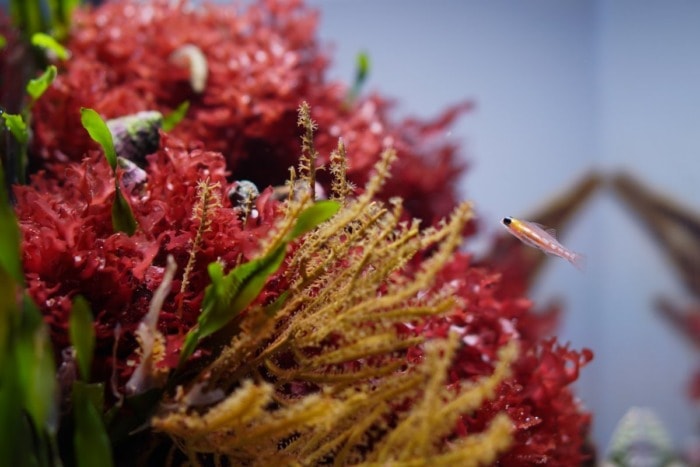
Live aquatic plants provide beauty and color to your setup but that is rarely considered an actual benefit.
However, a planted saltwater aquarium has several other distinct benefits:
- Plants with bushy textures provide shelter for fish to hide in;
- Some saltwater plants, like Dragon’s Tongue algae, are edible to herbivorous fish and can help as a part of a balanced diet for your aquatic pets;
- Live plants can help oxygenate and filter tank water, reducing harmful waste products, like phosphate and nitrate. By keeping nitrate at acceptable levels live plants the plants also outcompete microalgae for nutrients. This in itself reduces unsightly green algae that can take up residence on your substrate and tank walls;
- Having fast-growing “nutrient sponges” in your tank can protect it against abrupt ammonia spikes.
How to choose saltwater plants for your new tank as a beginner?
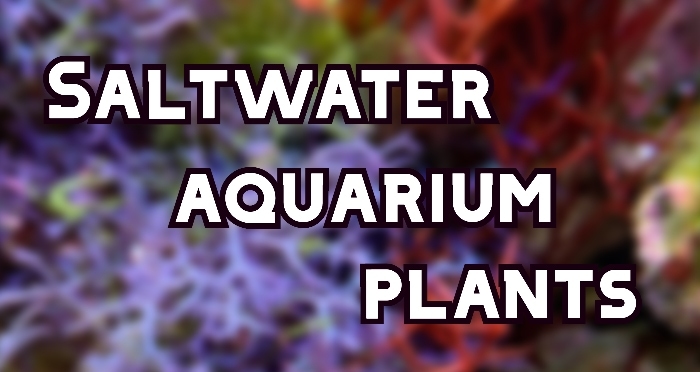
The most important thing when creating an aquascape of beautiful saltwater plants in your aquarium is to have a vision of it beforehand.
You’d want to be led by a color scheme.
It’s best if you have one main color of plants for the background, complimented by contrasting colors and textures for the rest.
For example, select 2 green plant species as your main ones and compliment them by bright red, pink and blue saltwater plants.
Plant the eye catchers with exotic textures in the front and foreground of the tank.
As main plants, you can always go with the classic green sea lettuce and green bush macroalgae.
From there on, the Blue Hypnea and the red Halymena Maculata can spice things up if you have a decent set of aquarium lights.
Add to that some fun-looking Spaghetti algae and Pine Cone algae for Nitrate control and you’re good.
There you have it – your new saltwater aquascape will have contrasting colors, different textures, will help with the water parameters in the tank and it will be relatively easy to look after and manage.
Conclusion
Having live plants in your saltwater tank is a surefire way to improve its health while adding beauty and color to its aquascape.
When choosing marine plants, select species that will do well with the lighting and water flow capacity of your aquarium.
Also, be sure to take into account whether or not the species you chose may become a tasty treat for your fish.
For an optimal setup, look for plants with contrasting shapes and colors, as well as a range of different heights.
A thoughtfully selected arrangement is one of the easiest ways to elevate a display system that will impress visitors to your home.


